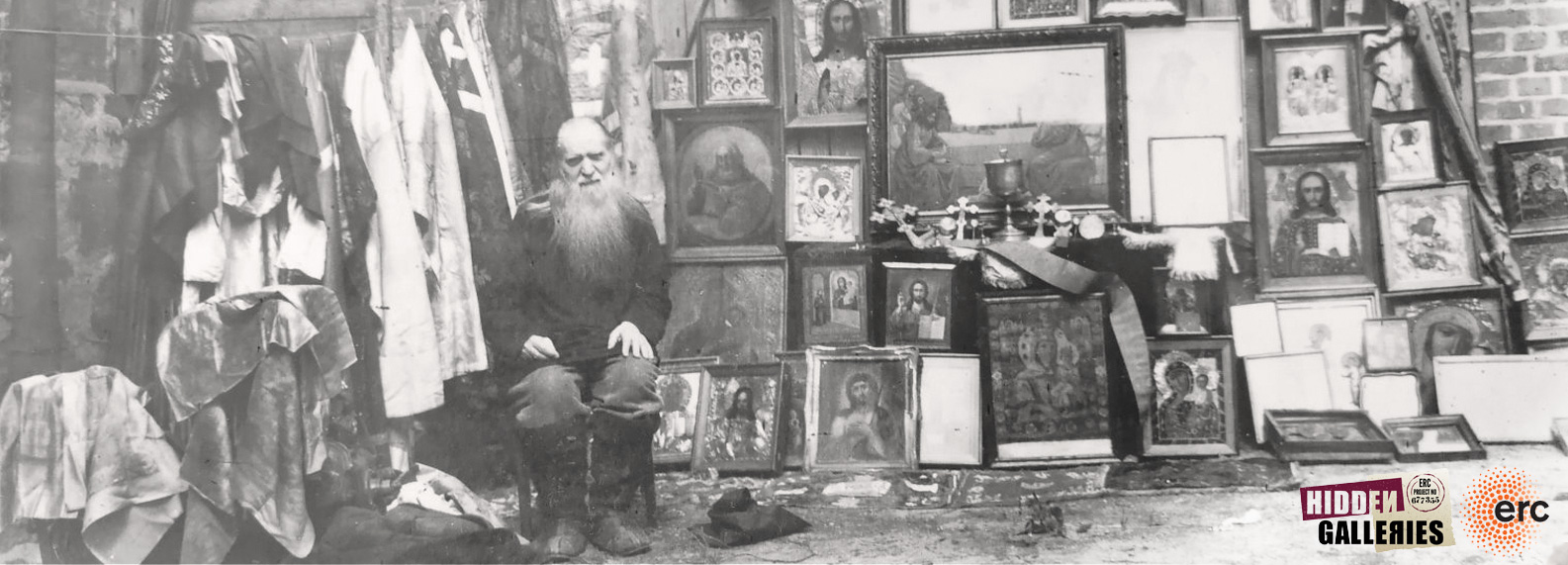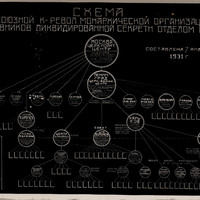True Orthodox Church secret police network scheme Ukraine
Item
Title
True Orthodox Church secret police network scheme Ukraine
Схеми релігійних зв'язків Істинно-православної церкви, Україна
Схемы религиозных связей Истинно-православной церкви, Украина
Description
This scheme of a religious network was produced as part of a review of criminal cases against believers of the True Orthodox Church. It was published in 1931 as a top-secret document by the Soviet secret police (OGPU) in Moscow. This image has been given the title "Scheme of the All-Union Counter-Revolutionary Monarchist Organisation of Churchmen (the 'True Orthodox Church'), liquidated by the Secret Political Department OGPU". Schemes such as this one were designed to represent the religious movement as an organised hierarchical structure, where the "ecclesiastical political centre" in Moscow and the "ecclesiastical administrative centre" in Leningrad were connected to religious groups in other towns in Russia, the Caucasus region and Ukraine.
These top-secret internal publications were circulated among other branches of the OGPU, including the one in Kiev, as exemplary collective penal cases – a sort of textbook for the OGPU’s struggle against the so-called “ecclesiastical-monarchist underground”. Clichéd citations from the interrogations and false confessions of arrested believers intended to reveal the political conspiracy disguised behind religious practices. It was a typical strategy to translate religious dissent in terms of political insurgency. The main charges against the believers were anti-Soviet agitation and propaganda and counter-revolutionary activities, including inciting the peasants to revolt against collectivisation.
The Russian True Orthodox Church, also known as the Catacomb Church, was formed in the early years of the Soviet Union as a reaction against the collaboration of the Russian Orthodox Church hierarchy with the Bolsheviks. After Metropolitan Sergii issued a declaration of loyalty to the Soviet regime in 1927, many Orthodox communities ceased to communicate with the Moscow Patriarchate, renounced the Soviet power and continued their religious life underground. True Orthodox believers were severely persecuted throughout the entire Soviet period. In 1930-1933, the Stalin’s secret police (OGPU) launched the all-Union “liquidation campaign” against the growing Orthodox dissent movements, which they collectively referred to as the “ecclesiastical-monarchist underground”. The True Orthodox Church was the main target. The wave of repression particularly affected religious communities in southern Russian provinces and in Ukraine, where popular religious dissent was notably influential among the peasantry. Hundreds of priests, monks and ordinary believers were repressed as a result of the campaign.
This document comes from the State Archive Branch of the Security Services of Ukraine, fond 13, spr. 385 (Kiev, Ukraine). Two internal publications in this archive fond also provide the OGPU's description of the so-called "ecclesiastical-political centre": its origins, political platform, leadership and its supposed "counter-revolutionary, anti-kolkhozes and insurgent activity". The description of religious criminal evidence are corroborated by standardised and formulaic statements of arrested individuals and witnesses.
For related entries see:
These top-secret internal publications were circulated among other branches of the OGPU, including the one in Kiev, as exemplary collective penal cases – a sort of textbook for the OGPU’s struggle against the so-called “ecclesiastical-monarchist underground”. Clichéd citations from the interrogations and false confessions of arrested believers intended to reveal the political conspiracy disguised behind religious practices. It was a typical strategy to translate religious dissent in terms of political insurgency. The main charges against the believers were anti-Soviet agitation and propaganda and counter-revolutionary activities, including inciting the peasants to revolt against collectivisation.
The Russian True Orthodox Church, also known as the Catacomb Church, was formed in the early years of the Soviet Union as a reaction against the collaboration of the Russian Orthodox Church hierarchy with the Bolsheviks. After Metropolitan Sergii issued a declaration of loyalty to the Soviet regime in 1927, many Orthodox communities ceased to communicate with the Moscow Patriarchate, renounced the Soviet power and continued their religious life underground. True Orthodox believers were severely persecuted throughout the entire Soviet period. In 1930-1933, the Stalin’s secret police (OGPU) launched the all-Union “liquidation campaign” against the growing Orthodox dissent movements, which they collectively referred to as the “ecclesiastical-monarchist underground”. The True Orthodox Church was the main target. The wave of repression particularly affected religious communities in southern Russian provinces and in Ukraine, where popular religious dissent was notably influential among the peasantry. Hundreds of priests, monks and ordinary believers were repressed as a result of the campaign.
This document comes from the State Archive Branch of the Security Services of Ukraine, fond 13, spr. 385 (Kiev, Ukraine). Two internal publications in this archive fond also provide the OGPU's description of the so-called "ecclesiastical-political centre": its origins, political platform, leadership and its supposed "counter-revolutionary, anti-kolkhozes and insurgent activity". The description of religious criminal evidence are corroborated by standardised and formulaic statements of arrested individuals and witnesses.
For related entries see:
Ця схема релігійної мережі під назвою “Схема Всесоюзної контрреволюційної монархістської організації церковників (Істинно-православна церква), ліквідованої секретним відділом ОДПУ” була створена для перегляду справ проти віруючих Істинно-православної церкви. Вона була опублікована у 1931р. під грифом цiлком таємно радянською таємною поліцією (ОДПУ) у Москві. Подібні схеми були розроблені з метою показати релігійні течії у вигляді організованої ієрархічної системи, де “церковний політичний центр” у Москві і “церковний адміністративний центр” у Ленінграді були об’єднані з релігійними групами в інших містах Росії, Кавказькому регіоні і Україні.
Схема була долучена до таємної внутрішньої публікації, яка передавалася до республіканських відділів ОДПУ, включаючи київський відділ, як зразкова колективна кримінальна справа – свого роду підручник для боротьби ОДПУ проти так званого “церковно-монархічного підпілля”. Кліше у цитатах допитів, а також, формалізовані зізнання заарештованих віруючих намагалися показати політичні мотиви, замасковані під релігійні практики. Типовою стратегією було представлення релігійного інакомислення як політичного опору. Основними звинуваченнями проти віруючих були антирадянська агітація і пропаганда і контрреволюційна діяльність, включаючи закликання селян до опору проти колективізації.
Істинно-православна церква, також відома як катакомбна церква, сформувалася у ранні роки Радянського Союзу як реакція проти співпраці російської Православної церкви, особливо, високих рангів священнослужителів, з більшовиками. Після того, як митрополит Сергій підписав декларацію вірності Радянському режиму у 1927 р., багато православних громад припинили комунікацію з московським патріархатом, відмовились визнавати радянську владу і продовжили свою релігійну діяльність у підпіллі. Істинно-православні віруючі були переслідувані увесь радянський період. У 1930-1933 рр., сталінська таємна поліція (ОДПУ) розпочала всесоюзну “операцію ліквідації ” зростаючих інакомислячих православних рухів, які вони називали “церковно-монархістським підпіллям”. Істинно-православна церква була основною мішенню. Хвиля репресій особливо зачепила релігійні громади в південних провінціях Росії і в Україні, де народні релігійні течії мали великий вплив на селян. Сотні священиків, ченців і просто віруючих були репресовані внаслідок цієї операції.
Оригінал документу зберігається у Галузевому державному архівi Служби безпеки України, фонд 13, спр. 385 (Київ, Україна). Публікація також містить описання того, що ОДПУ називали “церковно-політичним центром”: його виникнення, політичну платформу, лідерів та його, як вважалося, “контрреволюційну, анти-колгоспну і повстанську діяльність”. Описання релігійних кримінальних доказів було підтверджено стандартними і формалізованими ствердженнями заарештованих і свідків.
Subject
Communism and Christianity--Europe, Eastern
Communism--Europe, Eastern--History--20th century
Secret police (secret service)
Religious groups
Christian sects--Soviet Union
Communism and culture--Soviet Union
Communism--Soviet Union--History--Sources
Evidence fabrication
Trials (Political crimes and offenses)--Soviet Union
Soviet Union--Obʺedinennoe gosudarstvennoe politicheskoe upravlenie
Creator
Tatiana Vagramenko
Source
Галузевий державний архів Служби безпеки України
ГДА СБУ ф. 13, спр. 385, 387
https://ssu.gov.ua/
ГДА СБУ ф. 13, спр. 385, 387
https://ssu.gov.ua/
Publisher
This project has received funding from the European Research Council (ERC) under the European Union’s Horizon 2020 research and innovation programme No . 677355
The research for this entry was funded by Irish Research Council, GOIPD/2017/764
The research for this entry was funded by Irish Research Council, GOIPD/2017/764
Date
1931
Rights
Copyright for these images belongs to the State Archive Branch of the Security Services of Ukraine
https://ssu.gov.ua/
https://ssu.gov.ua/
Format
Image/ jpg
Image
Language
RU
Type
Image
Identifier
SBU Archive, f. 13, spr. 385
https://ssu.gov.ua/
https://ssu.gov.ua/
Coverage
20th Century
Ukraine, Soviet Union
Ukraine, Soviet Union
Bibliographic Citation
Tatiana Vagramenko, "True Orthodox Church secret police network scheme Ukraine"
Date Created
2018

